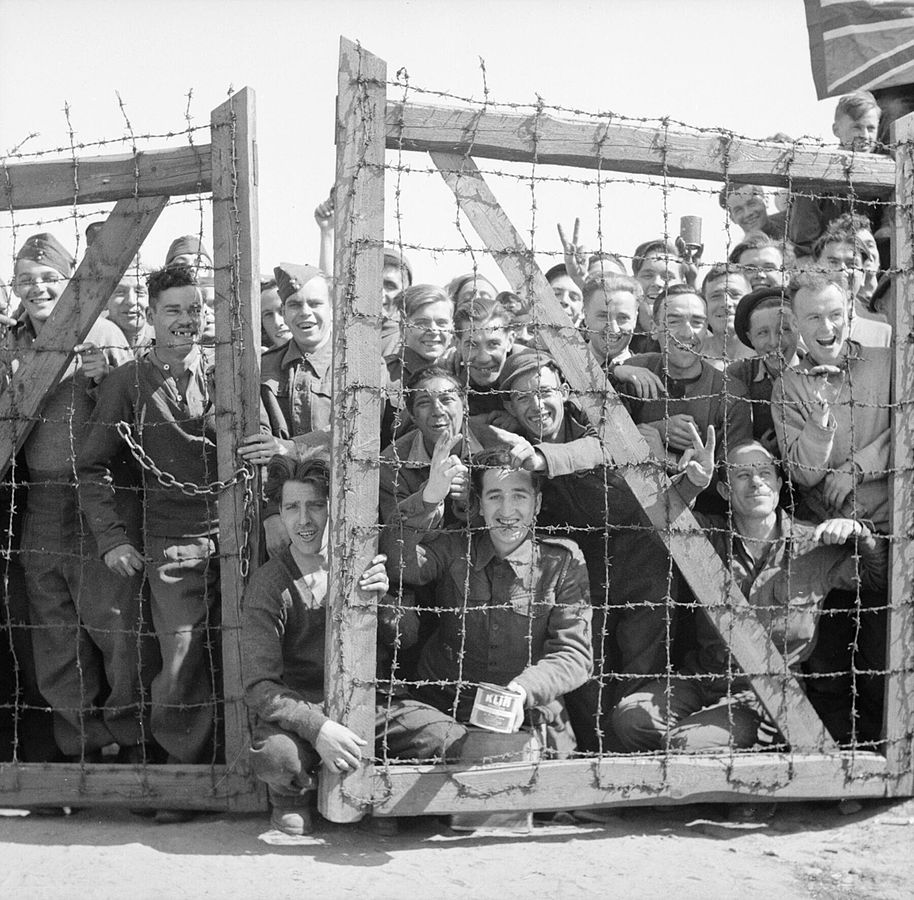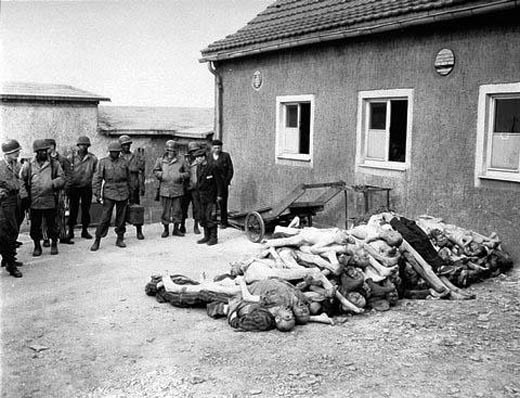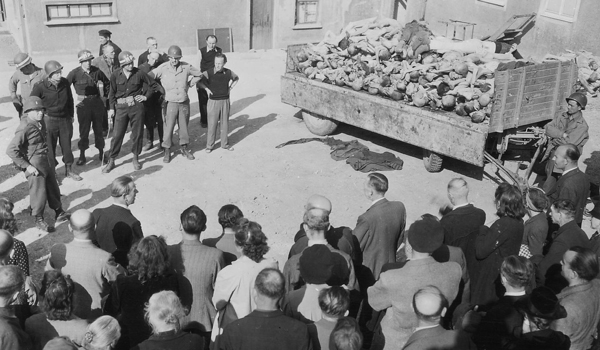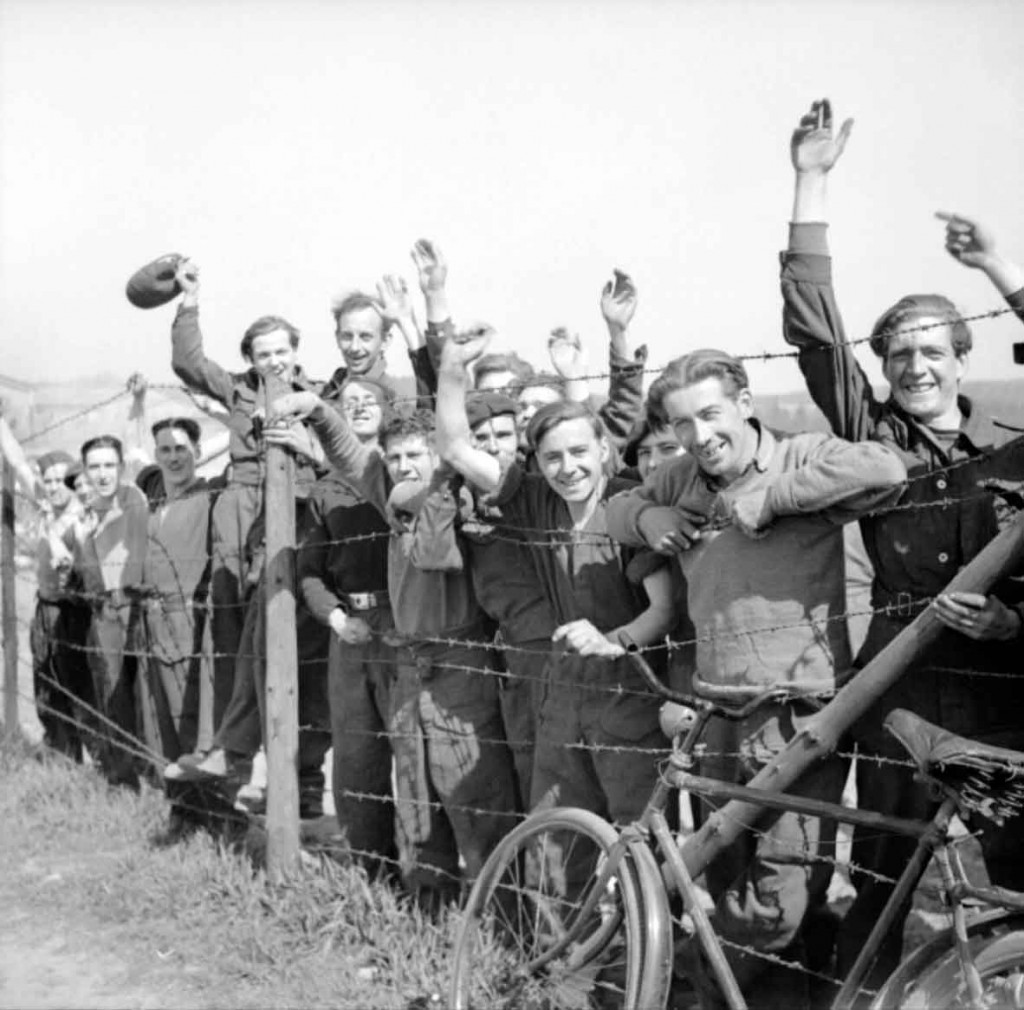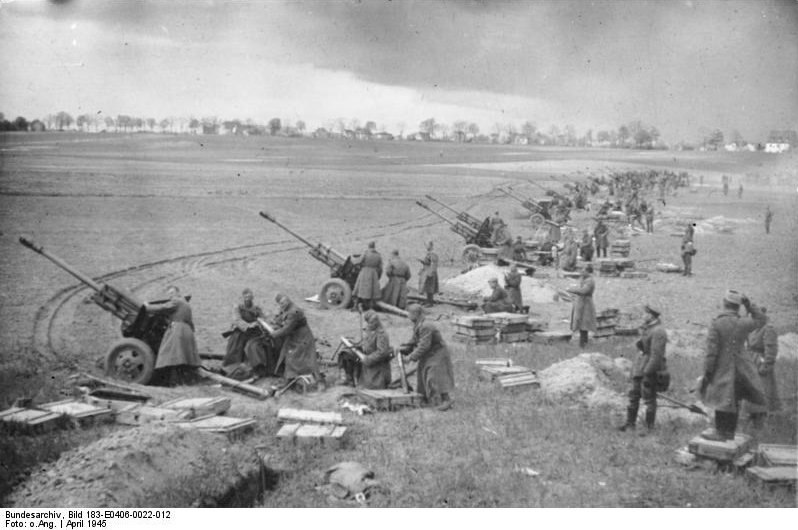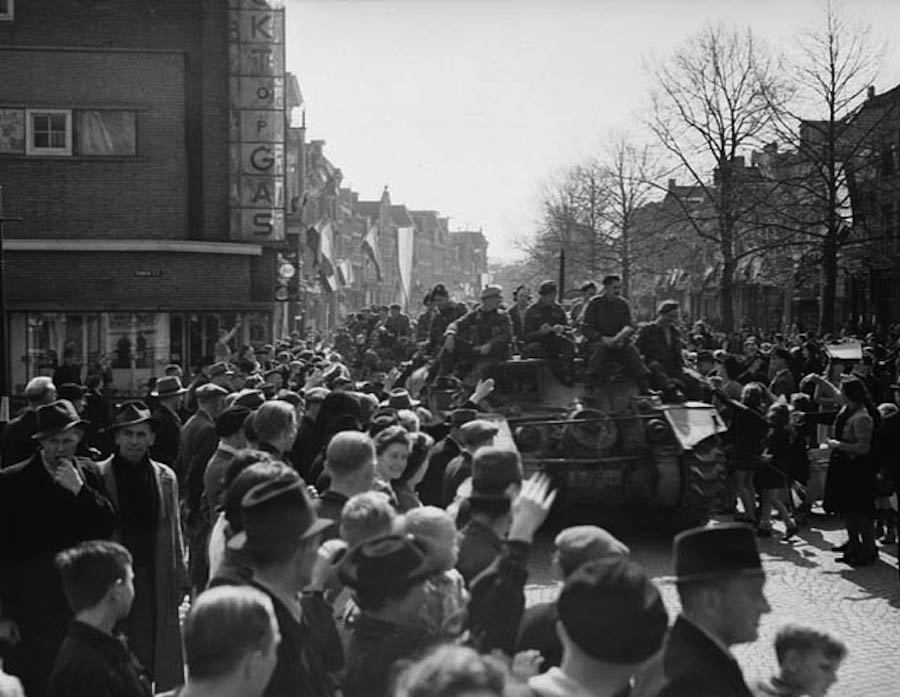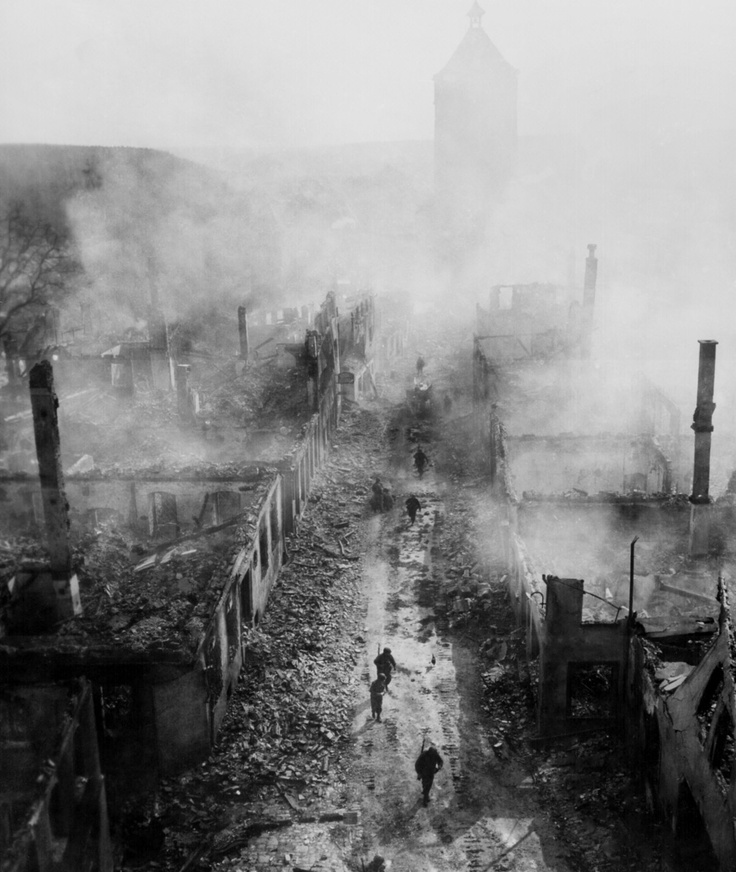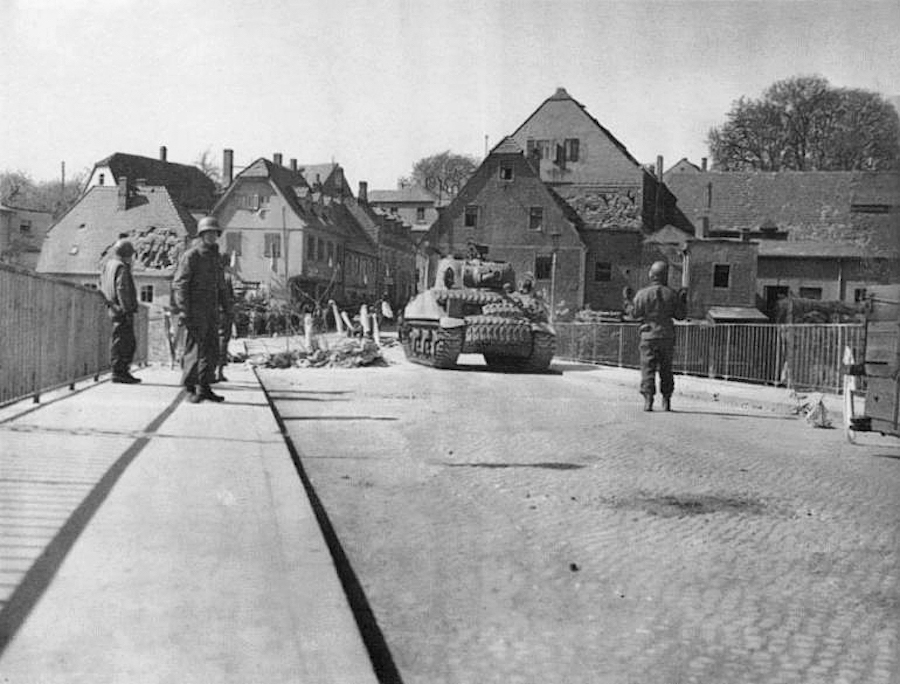Air Operations, CBI
BURMA- 22 10th Air Force fighter-bombers attack troops around Ke-hsi Mansam.
- 19 fighter-bombers attack bridges immediately behind the Japanese Army battle lines.
- 18 308th Heavy Bomb Group B-24s attack stores at Linfen.
- 3 B-24s attack targets of opportunity in the Bakli Bay and Canton areas.
- 10 341st Medium Bomb Group B-25s attack a bridge, buildings, and river and rail traffic at Kweilin, Shanhsien, and Yungfengshih.
- Nearly 120 14th Air Force fighter-bombers attack targets across southern and eastern China.
Air Operations, East Indies
XIII Fighter Command P-38s attack Tarakan and a tank farm at Lingkas, Borneo.
[Air Operations, Europe
Russian and RAF fighter planes join together from the east and west for the first time while attacking a train near Dresden.
RAF BOMBER COMMAND
Daylight Ops:
- 18 Lancasters of No. 617 Squadron fly to Swinemünde to attack the pocket battleship Lützow. The force flies through intense flak. 15 aircraft manage to bomb the target with Tallboys or with 1,000-pounders. The effects of one near miss with a Tallboy tear a large hole in the bottom of the Lützow and she sinks in shallow water at her moorings.
- 1 Lancaster is shot down, No. 617 Squadron's last loss of the war, and all but 2 aircraft are damaged.
- 222 Lancasters and 11 Mosquitos of No. 5 Group carry out an accurate attack on the railway yards at Pilsen.
- 1 Lancaster crashes in France.
- 167 Lancasters and 8 Mosquitos of Nos. 6 and 8 Groups attack the railway yards at Schwandorf causing severe damage.
- 1 Lancaster is lost.
- 19 Halifaxes of No. 6 Group and 4 Pathfinder Mosquitos are sent to Gablingen airfield, 64 Mosquitos to Berlin and 23 to Munich, and there are 35 Mosquito patrols and 57 RCM sorties.
- 2 Halifaxes and 1 Fortress of No. 100 Group are lost.
ETO:
- VIII Fighter Command fighters from 15 goups claim the destruction of a record 747 Luftwaffe aircraft on the ground during strafing missions against airfields throughout Germany and Czechoslovakia.
- 34 VIII Fighter Command fighters are downed, mostly by light flak and small arms.
- During the morning, 485 3rd Air Division B-17s attack the defensive line and anti-tank defenses around Bordeaux.
- During the afternoon, 294 1st Air Division B-17s attack a marshalling yard and two rail bridges at Regensburg.
- 77 1st Air Division B-17s attack a marshalling yard at Plattling.
- 76 1st Air Division B-17s attack a rail bridge at Straubing.
- 273 2nd Air Division B-24s attack a marshalling yard at Landshut.
- 1 B-24 is lost.
CZECHOSLOVAKIA:
- Pilots of tthe XIX TAC's 368th Fighter Group down 3 Luftwaffe fighters over Czechoslovakia at 1430 hours.
- Approximately 450 9th Air Divisoin bombers attack an ordnance depot, two marshalling yards, a communications center, and various gun emplacements.
- Throughout the day, 9th Air Force fighters destroy 215 Luftwaffe on the ground and damage 190 others, the best one-day dally of its kind in the war.
- 1 P-47 is lost.
- 9th and 1st Tactical Air Force fighter pilots down 30 Luftwaffe fighters over Germany between 0745 and 1900 hours.
ITALY:
- 12th Air Force B-25s attack bridges spanning the Reno River and troop concentrations on the British 8th Army front.
- XXII TAC P-47s mount 520 effective ground-support sorties in support of the US 5th Army.
- During the night, XXII TAC A-20s and A-26s attack crossing points in the Po River valley and several defended towns near Bologna.
AUSTRIA:
- 5 Luftwaffe aircraft are downed over or near Wels Airdrome between 1415 and 1450 hours by 52nd Fighter Group P-51 pilots.
- Although more than 700 15th Air Force heavy-bomber sorties are aborted because of bad weather, 98 B-24s are able to attack defended positions near Bologna.
Air Operations, Formosa
- 22nd, 43rd, and 90th Heavy Bomb group B-24s attack the airfield at Matsuyama and aircraft dispersed from the base in a nearby town.
- 380th Heavy Bomb Group B-24s attack the Giran airfield.
- 36 38th and 345th Medium Bomb group B-25s attack the airfield at Nanseiho and Osono, then strafe targets of opportunity as they traverse Formosa lengthwise from north to south.
Air Operations, Japan
- Guided by XXI Bomber Command B-29 navigational escorts, VII Fighter Command P-51s based on Iwo Jima strafe and bomb the Kanoya airfield comples on Kyushu. Also, VMB-612 PBJs, escorted by a squadron of the 21st Fighter Group P-51s, mount a rocket attack against the same airfield complex.
- No Japanese aircraft are encountered, but 4 P-51s and 2 of their pilots are lost to ground fire.
- 6 28th Composite Bomb Group B-24s attack the Kataoka naval base with the aid of radar guidance.
Air Operations, Philippines
- V Bomber Command B-24s attack Carabao Island.
- 42nd Medium Bomb Group B-25s sweep highways on Mindanao.
- FEAF fighter-bombers attack numerous targets throughout the Philippines.
- ;While providing air support for US 8th Army troops on Jolo Island in the Sulu Archipelago, 1st Marine Aircraft Wing SBDs and F4Us based at nearby Mindanao's Moret Field join land-based artillery in attempting to help the infantry breach the island’s main defensive sector on Mount Daho. Such attempts prove futile.
Air Operations, Ryukyus
- US Navy and Marine Corps aircraft support the US 10th Army on Okinawa and mount pre-invasion attacks against Ie Shima.
- Task Force 57 aircraft attack airfields in the Sakishima Islands.
- 12 VOC-1 FMs attack Minami Daito and Kita Daito, 200 miles east of Okinawa.
- As Task Force 58 carrier aircraft attempt to neutralize airfields on Kyushu, an estimated 400 Japanese aircraft mount a major attack against the carriers and numerous ships off Okinawa. Kamikaze aircraft sink 1 US destroyer and damage 11 other ships, including the fleet carrier USS Intrepid, which suffers structural damage and must return to the United States for repair. The picket destroyer USS Laffey is attacked by up to 50 Japanese aircraft. During an epic 80-minute battle beginning at 0827 hours, the ship undergoes direct attack by 22 aircraft and is struck by 4 bombs and 6 kamikazes. US carrier aircraft shoot down or chase off many of the attackers, but the Laffey’s own guns account for 8 or 9, and a support landing craft, LCS-51, accounts for 5 or 6 others. Despite grievous harm and serious crew losses (31 killed and 72 wounded), the plucky destroyer is towed to safety, patched, and ultimately sails for Guam under her own power.
- US Navy carrier-based F6Fs, F4Us, and FMs down 157 Japanese aircraft between 0400 and 2115 hours.
- US Marine Corps land- and carrier-based F4Us down 28 D3A 'Val' dive bombers, 2 G4M 'Betty' bombers, 1 Ki-48 'Lily' bomber, 1 Ki-49 'Helen' bomber, 2 B5N 'Kate' torpedo bombers, and 4 fighters in ongoing engagements between 0740 and 1040 hours.
- VMF-451 F4Us down 2 D3A 'Val' dive bombers near Okinawa at 1357 hours.
- VMF-221 F4Us down 4 fighters at sea between 1500 and 1530 hours.
- VMF(N)-542 F6Fs down 1 A6M Zero and 1 Ki-84 'Frank' fighter 45 miles west of Okinawa at 1845 hours.
Allied Planning
Gen Carl A. Spaatz, commander of US Strategic Air Forces in Europe, announces that all strategic operations have ceased and air units will henceforth merely engage in mopping-up action against Germany.
[Baltic Sea
- In the greatest maritime loss in history, during the night 6,220 refugees from Danzig drown when the German 5,230-ton transport Goya is sunk by the Soviet submarine L-3. The ship is torpedoed near Cape Rixhöft (Rozewie) and quickly sinks. A total of 18,000 Germans were lost when the refugee ships in the Baltic were subjected to constand Allied air and naval attack. 16 such vessels were sunk between January and May.
- U-78 was never fully operational, but spent her entire service as a generating plant or a training submarine. She is shelled and sunk by Soviet field artillery as the Germans evacuate Pillau.
| Class | Type VIIC |
| CO | Oberleutnant zur See Horst Hubsch |
| Location | Baltic, Pillau |
| Cause | Shore artillery |
| Casualties | Unknown |
| Survivors | Unknown |
Battle of the Atlantic
- Escort Group 17, consisting of the British frigate Loch Killin, the frigate Cranstown and the frigate Burges, are trailing a convoy when Loch Killin obtains an asdic contact. Three Squid attacks are made before the U-boat surfaces and is finished off by depth charges and gunfire.
- U-1274 had attacked and sunk the tanker Athelduke (8966t) in Convoy FS-1784. The British destroyer Viceroy counterattacks, but sees no results for her effort. She returns eight days later finding the target in the same area. A series of attacks result in much wreckage coming to the surface.
|
|
- The German submarines U-880 and U-1235 are sunk by the US destroyer escorts Frost (DE-144) and Stanton (DE-247) in the North Atlantic area as part of the increased anti-submarine campaign of Operation TEARDROP.
- U-190 sinks the Canadian minesweeper Esquimalt (590t) near Halifax, Nova Scotia with the loss of 44 of her crew. 26 survivors are picked up by the British minesweeper Sarnia.
|
|
Burma
Advanced guards of the 5th Indian Div, IV Corps, occupy Shwemyo without meeting any resistance, but are held up on the outskirts of the town by intense Japanese fire. In the Arakan, Taungup falls to the British forces.
[Diplomatic Relations
President Truman, addressing a joint session of Congress, reaffirms his commitment to the unconditional surrender of Germany and Japan.
Troubled by the Soviet machinations in Poland, Truman and Churchill send a letter to Stalin appealing to him to live up to the Yalta agreements.
[Eastern Front
After receiving Eisenhower's March 28 message Stalin has become convinced that the British and Americans will not head for southern Germany but go for Berlin. He has, therefore, ordered preparations for the last great offensive to take the German capital to be hurried forward. Zhukov's 1st Belorussian Front and Ivan Konev's 1st Ukraine Front are to lead the attack with support from Konstantin Rokossovsky in the north. Perhaps in an effort to divide the glory and retain credit for himself and not the army or any one of its leaders, Stalin has not made it clear whether Zhukov or Konev has to make the final assault on the city. Between them the two Soviet marshals have well over 2,000,000 men, more than 6,000 tanks and self-propelled guns, a similar number of aircraft and almost 16,000 guns
one gun for every 13 feet of the front on which the assault will take place. Although the Germans have about 1,000,000 men deployed in fairly strong and well-prepared positions overlooking the west bank of the Oder and Neisse, they are totally outmatched in the air and on the ground they have nothing to compare with the lavish scale of Soviet equipment. The German troops are organized in Gen Gotthard Heinrici's Army Group Vistula and Field Marshal Ferdinand Schörner's Army Group Center.
At 5:00a.m. the 1st Ukraine Front opens the offensive against Berlin with a massive bombardment of the positions of the German 4th Panzer Army, Army Group Center, on the Neisse River in the Triebel area. At 7:00a.m. the tanks and infantry go in, taking a bridgehead over the river. There are powerful attacks also in the area of Ratibor. At 6:15a.m. the 1st Belorussian Front attacks the sector held by the Vistula Army Group north and south of Frankfurt-on-the-Oder. The Russian 33rd Army, south of the town, makes the most progress, advancing several miles.
In Austria the 3rd Ukraine Front presses on west of Vienna, taking St Pölten and Fürstenfeld. The 2nd Ukraine Front gains ground in Czechoslovakia southeast of Brno. Hitler sends his last Order of the Day to his Eastern Front armies: 'He who gives the order to retreat is to be shot on the spot.'
GERMANYThe Soviet Berlin Offensive begins. For this assault the Soviets have amassed 2.5 million troops, 41,000 artillery pieces, 6,200 tanks and assault guns, 100,000 motor vehicles and 7,200 aircraft, divided between the 1st Belorussian, 2nd Belorussian and 1st Ukrainian Fronts. Facing this host is Army Group Vistula (3rd Panzer and 9th Armies with the LVI Panzer Corps in reserve
200,000 troops, 750 tanks and assault guns and 1,500 artillery pieces) and the northern flank of Army Group Center (4th Panzer Army
100,000 troops and 200 tanks and assault guns).
The 1st Belorussian Front (Polish 1st, 1st Guards Tank, 2nd Guards Tank, 3rd, 3rd Shock, 5th Shock, 8th Guards, 33rd, 47th, 61st and 69th Armies) launches its initial attack against the Seelow Heights, bu the Germans have anticipated this move and withdrawn some way back, thus the Soviet artillery 'punches air', and Zhukov's tactics of using searchlights to aid the attack actually illuminates the attackers. As the 8th Guards Army struggles forward, Zhukov commits the 1st Guards Tank and 2nd Guards Tank Armies, which creates chaos. Although the Soviets inch forward, they lose many tanks. The 1st Ukrainian Front (Polish 2nd, 3rd Guards, 3rd Guards Tank, 4th Guards Tank, 5th Guards, 13th, 28th and 52nd Armies), at the Neisse River, has more success, establishing a bridgehead.[MORE]
[Germany, Home Front
Hitler orders that 'he who gives the order to retreat is to be shot on the spot.' Since the first of the month Allied forces on the western front have captured 755,573 German troops.
[Germany, Strategy
Hitler issues his order of the day regarding the new Soviet offensive against Berlin: 'For the last time our deadly enemies, the Jewish Bolsheviks, have launched their massive forces to the attack. Their aim is to reduce Germany to runis and to exterminate our peoples... If every soldier on the Eastern front does his duty in the days and weeks which lie ahead, the last assault of Asia will crumple, just as the invasion by our enemies in the West will finally fail, in spite of everything.'
[Italy
The offensives of the US 5th and British 8th Armies toward the Lombard plain make progress.
[Okinawa
The 6th Marine Div, US III Amphibious Corps, sends its 7 battalions to attack the Yae-Take heights in the Motobu peninsula. The fighting is savage and the outcome remains uncertain all day. At 8:00a.m., after air and naval bombardment, the US 77th Div begins the landing at Ie Shima, west of the Motobu peninsula. The assault troops advance quickly into the interior, more held up by the mines than by the Japanese, and capture two-thirds of the island, including the airfield; Japanese counterattacks are driven off.
Despite the air raids on Kyushu, renewed again today, kamikaze pilots attack American ships off Okinawa in force, sinking the destroyer Pringle (DD-477), seriously damaging the aircraft carrier Intrepid (CV-11) and, less seriously, the battleship Missouri (BB-63), the destroyers Bryant (DD-665) and McDermut (DD-677), the destroyer escort Bowers (DE-637), the high-speed minesweepers Hobson (DMS-26) and Harding (DMS-28) and the minesweeper Champion (AM-314).
[Pacific
- The Japanese Coast Defense Vessel No.73 is sunk by the US submarine Sunfish (SS-281) off Honshu, Japan.
- The US submarine Sea Dog (SS-401) sinks the Japanese merchant cargo ship Toko Maru (6850t) off Mikura Jima.
Philippines
On Luzon the 158th Regimental Combat Group repels several strong Japanese counterattacks at San Francisco, and occupies the southern point of the Bicol peninsula, make the northern entrance to the San Bernardino Strait safe for American shipping. In the I Corps sector, the US 37th Division overcomes the dogged resistance of the Japanese on the hills north of San Francisco and advances north along the west coast. In the XIV Corps sector, the 511th Infantry of the 11th Airborne Division takes Mount Malepunyo and Mount Dalaga, while the 1st Cavalry Division shuts up some of the Japanese units in a number of pockets north and northwest of Mount Mataasna Bundoc.
After a 2-day air and naval preparation, a battalion of the 151st Infantry lands unopposed on Carabao Island, the last objective in Manila Bay not yet secured, and occupies it.
The Americal Div makes slow progress on Cebu against the Japanese positions on the hills around Cebu City. The Japanese retire during the following night. In the Sulu archipelago units of the US 41st Division eliminate the remaining Japanese resistance.
[Western Front
The II Corps of the Canadian 1st Army take Groningen.
In the British 2nd Army sector, the XXX Corps is coming close to Bremen, while at Ülzen units of the VIII Corps meet with vigorous resistance from the German 20th Army.
The XVIII Airborne Corps, US 1st Army, pushes on further in the Ruhr pocket, where German resistance is quickly weakening; many units surrender, and so far the Americans have taken at least 20,000 prisoners. The VII and V Corps extend their bridgehead on the east bank of the Mulde River; units of the 9th Arm Div, V Corps, enter Colditz, while the 69th Div advances northeast toward Leipzig.
In the sector in which the units of the US 7th Army are engaged, the XV Corps advances toward Nuremberg and reaches the outskirts of the city. The special POW camp at Colditz is freed by other Allies units.
[Images from April 16, 1945
|
|
|
|
|
|
|
|
